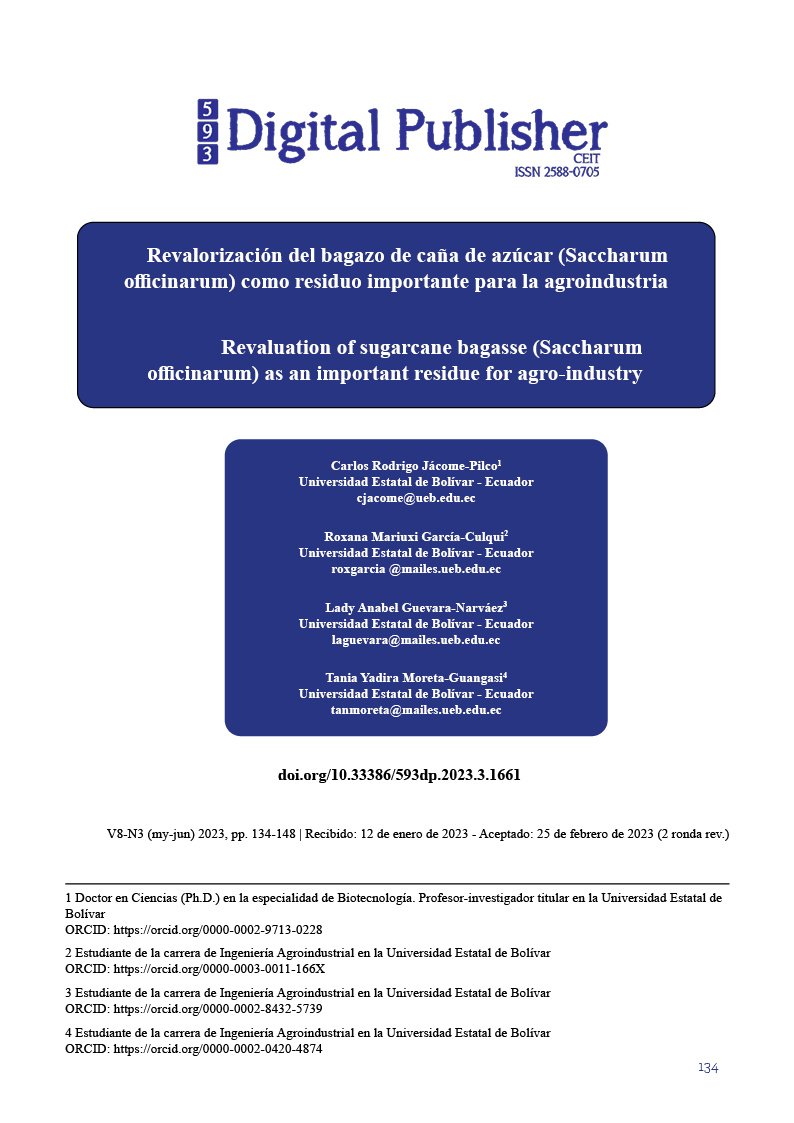Revaluation of sugarcane bagasse (Saccharum officinarum) as an important residue for agro-industry
Main Article Content
Abstract
Sugarcane of the genus Saccharum officinarum is mainly used for sugar production; however, the waste generated in the various stages of production is a worldwide problem due to the environmental impact, since in several industries the waste is not properly disposed of, wasting its potential. Therefore, the present review work focuses on searching through the literature between the years 2018 and 2022 for alternatives for the utilization of sugarcane bagasse waste (Saccharum officinarum), having as inclusion criteria the works included in these years as well as the relevance that exists in the agribusiness sector in the same way. The exclusion criteria rejected all articles that did not have the complete text of the sensitivity as well as its relation in languages other than Spanish and English. In this way, it was possible to establish as results, using a qualitative approach and a descriptive level of research, that the revaluation of these residues can generate new products that can be used on a daily basis and make use of new technologies. In addition, the results indicate that the main uses given to this residue are for energy production as butanol and biogas, as well as for cattle feed; bagasse ashes are also used as additives in construction; it is also an important material in biorefineries and is used as biofertilizer.
Downloads
Article Details

This work is licensed under a Creative Commons Attribution-NonCommercial-ShareAlike 4.0 International License.
1. Derechos de autor
Las obras que se publican en 593 Digital Publisher CEIT están sujetas a los siguientes términos:
1.1. 593 Digital Publisher CEIT, conserva los derechos patrimoniales (copyright) de las obras publicadas, favorece y permite la reutilización de las mismas bajo la licencia Licencia Creative Commons 4.0 de Reconocimiento-NoComercial-CompartirIgual 4.0, por lo cual se pueden copiar, usar, difundir, transmitir y exponer públicamente, siempre que:
1.1.a. Se cite la autoría y fuente original de su publicación (revista, editorial, URL).
1.1.b. No se usen para fines comerciales u onerosos.
1.1.c. Se mencione la existencia y especificaciones de esta licencia de uso.
References
Alemán, R., Domínguez, J., Bravo, C., Iza, E., Reyes, H., Freile, J., Alba, J., Marino, E., & Gutiérrez, E. (2019). Variación de algunos indicadores fisiológicos y componentes del rendimiento con la fertilización orgánica en la variedad de caña de azúcar cristalina en las condiciones de la Amazonía ecuatoriana. Iberoamericana Ambiente & Sustentabilidad, 2(1), 16-24. https://doi.org/10.46380/rias.v2i1.34
Ali, N., Mohd, S., Hadipramana, J., & Abdul, S. (2017). Potential Mixture of POFA and SCBA as Cement Replacement in Concrete – A Review. MATEC, 103, 8. https://doi.org/10.1051/matecconf/20171030100
Anua, A., Kumar, A., Kumarc, V., & Singhad, B. (2021). Cellulosic and hemicellulosic fractions of sugarcane bagasse: Potential, challenges and future perspective. International Journal of Biological Macromolecules, 169, 564-582. https://doi.org/10.1016/j.ijbiomac.2020.12.175
Arias-Cedeño, Q., López-Sánchez, R., Sainz-Rosales, L., Verdecia-Casanova, M., & Eichler-Löbermann, B. (2021). Potencial fertilizante de cenizas de bagazo de caña de azúcar de industrias azucareras. Revista Cubana de Química, 33(3), 452-466.
Armas, A., Morales, M., Albernas, Y., & Gonzáles, E. (2019). Proyección de una industria azucarera para transformarse en una biorrefinería a partir de biocombustibles de segunda y tercera generación. Tecnología Química, 39(3), 489-507.
Chen, W., Zhang, S., Li, Y., Wu, H., Meng, Q., & Zhou, Z. (2019). Steam-exploded sugarcane bagasse as a potential beef cattle feedstock: Effects of different pretreatment conditions. Journal of animal science, 97(6), 2414-2423. https://doi.org/10.1093/jas/skz127
Chundawat, S., Pal, R., Zhao, C., Campbell, T., Teymouri, F., Videto, J., Nielson, C., Wieferich, B., Sousa, L., Dale, B., Balan, V., Aguado, J., Chipkar, S., Burke, E., & Ong, R. (2020). Ammonia fiber expansion (AFEX) pretreatment of lignocellulosic biomass. Journal of visualized experiments, 1-8. https://doi.org/10.3791/57488
Cordeiro, G. C., Andreão, P. V., & Tavares, L. M. (2019). Pozzolanic properties of ultrafine sugar cane bagasse ash produced by controlled burning. Heliyon, 5(10), e02566. https://doi.org/10.1016/j.heliyon.2019.e02566
De la torre, L., Tavera, M., & Mena, X. (2021). Desarrollo Sustentable y Aprovechamiento del Residuo de la Caña de Azúcar. Revista Multidisciplinaria de Avances de Investigación, 7(1), 12-26. https://www.remai.ipn.mx/index.php/REMAI/article/view/79/75
Debernardi-Vázquez, T., Aguilar-Rivera, N., & Núñez-Pastrana, R. (2021). Composting of Byproducts from the Orange (Citrus sinensis (L.) Osbeck) and Sugarcane (Saccharum spp. Hybrids). Investigación e ingeniería, 40(3), 81-88. https://doi.org/10.15446/ing.investig.v40n3.82877
Eixenberger, D., Carballo‑Arce, A., Vega‑Baudrit, J., Trimino‑Vazquez, H., Villegas‑Peñaranda, L., Stöbener, A., Aguilar, F., Mora‑Villalobos, J., Sandoval‑Barrantes, M., & Andreas, P. (2022). Tropical agroindustrial biowaste revalorization through integrative biorefneries—Review part II: pineapple, sugarcane and banana by products in Costa Rica. Biomass Conversion and Biorefnery. https://doi.org/10.1007/s13399-022-02721-9
FAOSTAT. (2020). FAO. Cultivos y productos de. Cultivos y productos de ganadería. https://www.fao.org/faostat/es/#data/QCL/visualize
Farfán, M., & Pastor, H. (2018). Ceniza de bagazo de caña de azúcar en la resistencia a la compresión del concreto. UCV-HACER. Revista de Investigación y Cultura, 7(3), 25-31. https://doi.org/10.18050/RevUCVHACER.v7n3a2
Freitas, J., Bilatto, S., Squinca, P., Pinto, A., Brondi, M., Bondancia, T., Batista, G., Klaic, R., & Farinas, C. (2021). Sugarcane biorefineries: Potential opportunities towards shifting from wastes to products. Cultivos y Productos Industriales, 172(15). https://doi.org/10.1016/j.indcrop.2021.114057
Izquierdo, J., Álvarez, M., & Rojas, M. (2019). Uso de la ceniza de bagazo de caña (CBC) como remplazo parcial del cemento Portland-caso Colombia. IBRACON, 1-15.
Jiménez, S., Matias, G., Chukwuemeka, T., Maciel, R., & Pinto, A. (2021). Three-stage repeated-batch immobilized cell fermentation to produce butanol from non-detoxified sugarcane bagasse hemicellulose hydrolysates. Bioresource Technology, 321, 1-9. https://doi.org/10.1016/j.biortech.2020.124504
Konde, K., Nagaranjan, S., Kumar, V., Patil, S., & Ranade, V. (2021). Sugarcane bagasse based biorefineries in India: Potential and challenges. Sustainable Energy Fuels, 5, 52-78. https://doi.org/10.1039/D0SE01332C
Lagos-Burbano, E., & Castro-Rincón, E. (2019). Caña de azúcar y subproductos de la agroindustria azucarera en la alimentación de rumiantes. Agronomía Mesoamericana, 30(3), 917-934. https://doi.org/10.15517/am.v30i3.34668
Legua-Cárdenas, J., Nunja-García, J., Caro-Soto, F., & Cruz-Nieto, D. (2021). Efecto de compost elaborado con subproductos de la caña de azúcar, para obtener mayor rendimiento en el cultivo de lechuga (Lactuca sativa L.). Polo del Conocimiento, 6(8), 1-14. https://doi.org/10.23857/pc.v6i8
Mamani, J., Llumipanta, F., Ramos, S., Rea, J., Alucho, J., Santos, D., Llanos, F., & Jácome, C. (2021). Sistemas de producción de biogás fundamento, técnicas de mejora, ventajas y desventajas. Agroindustrial Science, 11(2), 239-247. https://doi.org/10.17268/agroind.sci.2021.02.14
Mokomele, T., da Costa, L., Balan, V., Van Rensburg, E., Dale, B., & Görgens, J. (2018). Ethanol production potential from AFEXTM and steam-exploded sugarcane residues for sugarcane biorefineries. Biotechnol Biofuels, 11(127). https://doi.org/10.1186/s13068-018-1130-z.
Molavian, M., Ghorbani, G., Rafiee, H., & Beauchemin, K. (2020). Substitution of wheat straw with sugarcane bagasse in low-forage diets fed to mind-lactation dairy cown: Milk production, digestibity and chewig behavior. Journal of Dairy Science, 103(9), 8034-8047. https://doi.org/10.3168/jds.2020-18499
Morales-Zamora, M., Mesa-Garriga, L., Ley-Chong, N., de Armas, A., Acosta-Martinez, D., & González-Suárez, E. (2021). Estudios previo inversionistas para la producción de furfuraletanol y tableros a partir de bagazo de caña de azúcar. ION, 34(2), 17-29. https://doi.org/10.18273/revion.v34n2-2021002
Paredes-Cervantes, S., Barahona-Pérez, L., Barroso-Tanoira, F., & Ponce-Marbán, D. (2020). Biocombustibles y su potencial en el mercado energético mexicano. Revista de Economía, 37(94), 35-56. https://doi.org/10.33937/reveco.2020.128
Pavan, M., Ramos, D., Soares, M., Barufi, C., & Carvalho, M. (2021). Barriers to broaden the electricity production from biomass and biogas in Brazil. Future of Energy-efficient Operations and Production Systems, 32. https://doi.org/10.1590/0103-6513.20210064
Paz Paredes, C. E. (2022). Diseño de una central termoeléctrica de biomasa para Lambayeque, utilizando residuos agrícolas como el bagazo de caña de azúcar y cascarilla de arroz. http://repositorio.unprg.edu.pe/handle/20.500.12893/10364
Peña, S., & López, J. (2020). Desarrollo sostenible y oportunidad de aprendizaje de las biorrefinerías: Una alternativa de la biomasa. Revista de Ciencias Sociales, 26(2), 401-413.
Pérez, G., Hidalgo, C., Etchevers, J., Jong, B., Salgado, S., Valtierra, E., & López, M. (2021). Evaluación de biocarbón de caña de azúcar en el desarrollo de Pinus greggii Engelm. Ex Parl. En condiciones de vivero. Terra Latinoamericana, 39, 1-9. https://doi.org/10.28940/terra.v39i0.1343
Qing, X., Tao, J., San-Ji, G., Zhengxian, Y., & Nengsen, W. (2018). Characteristics and applications of sugar cane bagasse ash waste in cementitious materials. Materials, 12(1), 1-19. https://doi.org/10.3390/ma12010039
Reyes-Portillo, K. A., Soto-Simental, S., Hernández-Sánchez, H., Quintero-Lira, A., & Piloni-Martini, J. (2020). Alimentos funcionales a partir de calostro bovino. Boletín de Ciencias Agropecuarias del ICAP, 6(12), Art. 12. https://doi.org/10.29057/icap.v6i12.5924
Saraswathi, N., Kit, L., Hui, C., Ahmad, H., Bin, A., Boon, K., & Huang, M. (2019). Biobutanol production from sugarcane bagasse by Clostridium beijerinckii strains. Biotechology and Applied Biochemistry, 67(5), 1-7. https://doi.org/10.1002/bab.1865
Selim, A., Hasan, N., Rahman, A., Rahman, M., Islam, R., Bostami, R., Islam, S., & Tedeschi, L. (2022). Nutrient content and in vitro degradation study of some unconventional feed resources of Bangladesh. Heliyon, 8(5). https://doi.org/10.1016/j.heliyon.2022.e09496
Silva-Lora, E., Escobar-Palacios, J., Vargas-Nuncira, D., Martínez-Reyes, A., & Almazán del Olmo, O. (2015). Evaluación energética de la integración del proceso de obtención de biobutanol en una destilería autónoma. ICIDCA. Sobre los Derivados de la Caña de Azúcar, 49(3), 47-50.
Soares, I., Santos, N., João, F., Lima, M., Freitas, L., Borges, J., & Silva, R. (2020). Analysis of physical-chemical parameters and centesimal composition of sugar cane bagasse flour (Saccharum officinarum L. Research, Society and Development, 9(7), 1-14. http://dx.doi.org/10.33448/rsd-v9i7.4385
Vargas, Y., & Pérez, L. (2018). Aprovechamiento de residuos agroindustriales para el mejoramiento de la calidad del ambiental. Revista Facultad de Ciencias Básicas, 14(1), 59-72. https://doi.org/10.18359/rfcb.3108
Vidal, D., Torres, J., Mejía, R., & González, L. (2014). Estudio comparativo de cenizas de bagazo de caña como adición puzolánica. Reviasta Colombiana de Materiales, 5, 13-18.
Volverás-Mambuscay, B., González, C., Huertas, B., Kopp-Sanabria, E., & Ramírez-Durán, J. (2020). Efecto del fertilizante orgánico y mineral en rendimiento de caña panelera en Nariño, Colombia. Agronomía Mesoamericana, 31(3), 547-565. https://doi.org/10.15517/am.v31i3.37334





